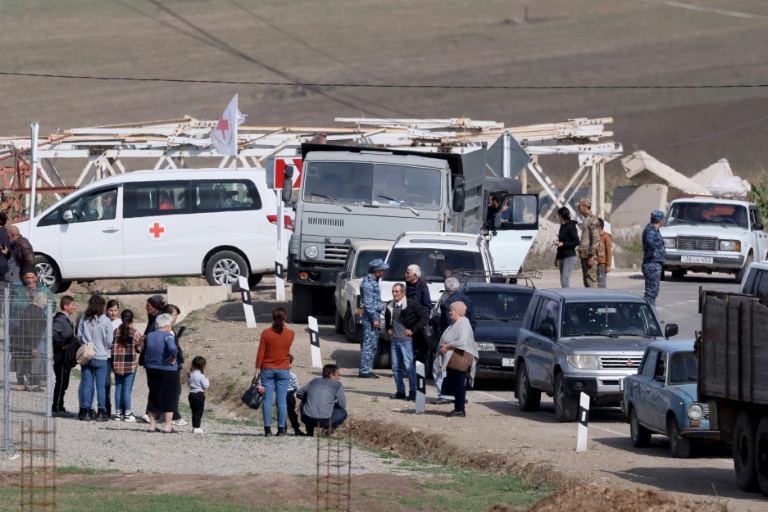Armenia receives first influx of Karabakh refugees

Refugees waited to be registered near the border town of Kornidzor
Kornidzor – Armenia prepared Monday to welcome a new flood of Nagorno-Karabakh refugees while the leaders of Azerbaijan and ally Turkey were set to hold a celebratory summit marking Baku’s victory over the rebel enclave.
And as Armenian Prime Minister Nikol Pashinyan blamed Russia for last week’s events, more protests were planned in Yerevan over his handling of the crisis.
According to the Armenian government, by Sunday evening 377 “forcefully displaced persons” had crossed from Azerbaijan.
Most of the refugees seen by AFP were women and children, including some from Eghtsahogh, where people took shelter around a Russian peacekeeping base after their village allegedly came under Azerbaijani shelling.
“Yesterday, we had to put down our rifles. So we left,” a man in his thirties from the village of Mets Shen told AFP as a first group of a few dozen people crossed the border and registered with Armenian officials in Kornidzor.
“We had 15 minutes to pack everything up,” he said, regretting having left behind his livestock and the grave of his three-year-old daughter.
“I didn’t tell her goodbye. I hope to go back.”
Azerbaijan’s President Ilham Aliyev intended to cement his victory by flying to his country’s western exclave of Nakhichevan for talks Monday with Turkish President Recep Tayyip Erdogan, his most important regional ally.
Turkey supplied Baku with a fleet of combat drones that helped Azerbaijan claw back a chunk of the disputed Nagorno-Karabakh territory in a six-week war three years ago.
The two leaders are scheduled to hold a groundbreaking ceremony for a new natural gas pipeline and open a modernised Azerbaijani military complex, a show of Turkish force contrasting sharply with Russia’s apparent withdrawal from the region.
– Pashinyan blames Russia –
Armenia’s premier c on Sunday sought to deflect blame onto long-standing ally Russia, signalling a breakdown in the countries’ security pact.
In nationally televised comments, the Armenian leader said the security agreements between the two countries had proved “insufficient” to protect the country, suggesting that he would seek new alliances.
Armenia is a member of the Collective Security Treaty Organisation (CSTO) — a Russian-dominated group comprising six post-Soviet states that had pledged to protect each other if attacked.
But Russia, bogged down in its own war in Ukraine, refused to come to Armenia’s assistance in the latest Nagorno-Karabakh conflict, arguing that Yerevan itself had recognised the disputed region as part of Azerbaijan.
Now, Russian peacekeepers are helping Azerbaijan disarm the Karabakh rebels.
Pashinyan also said Armenia should ratify the treaty which established the International Criminal Court (ICC), which has issued an arrest warrant for Russian President Vladimir Putin over the Ukraine war.
But he is under pressure at home from thousands of Nagorno-Karabakh supporters who have been rallying and blocking roads in Yerevan since Wednesday’s ceasefire deal.
They plan more disruptions over three days starting Monday, some voicing anger at Pashinyan’s pivot away from Moscow.
– Tension high –
The diplomatic manoeuvres come with tensions running high on the ground.
At the Kornidzor crossing, five kilometres (three miles) from the Hakari bridge on the convoy’s route, angry relatives had gathered to await news. One man was so frustrated he pulled out a knife in front of police.
“My son was in the army in Artsakh. He’s alive, but I’m worried for him,” said Alik Blbuyan, 43, using the name Karabakh’s ethnic Armenian population gave their breakaway statelet.
On the other side of the border in Azerbaijani settlements such as Terter and Beylagan, locals celebrated their government’s victory over the rebels.
State television played music paying tribute to the nation and its army, and the roadsides were lined with flags and portraits of dozens of local “martyrs”, fallen in the fighting during the previous 30 years.
